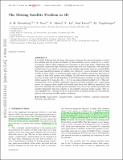| dc.contributor.author | Nierenberg, A. M. | |
| dc.contributor.author | Treu, T. | |
| dc.contributor.author | Menci, N. | |
| dc.contributor.author | Lu, Y. | |
| dc.contributor.author | Torrey, Paul A. | |
| dc.contributor.author | Vogelsberger, Mark | |
| dc.date.accessioned | 2017-05-01T18:13:50Z | |
| dc.date.available | 2017-05-01T18:13:50Z | |
| dc.date.issued | 2016-07 | |
| dc.date.submitted | 2016-03 | |
| dc.identifier.issn | 0035-8711 | |
| dc.identifier.issn | 1365-2966 | |
| dc.identifier.uri | http://hdl.handle.net/1721.1/108545 | |
| dc.description.abstract | It is widely believed that the large discrepancy between the observed number of satellite galaxies and the predicted number of dark subhaloes can be resolved via a variety of baryonic effects which suppress star formation in low-mass haloes. Supporting this hypothesis, numerous high-resolution simulations with star formation and associated feedback have been shown to reproduce the satellite luminosity function around Milky Way-mass simulated galaxies at redshift zero. However, a more stringent test of these models is their ability to simultaneously match the satellite luminosity functions of a range of host halo masses and redshifts. In this work, we measure the luminosity function of faint (sub-Small Magellanic Cloud luminosity) satellites around hosts with stellar masses 10.5 < log10M*/M⊙ < 11.5 to an unprecedented redshift of 1.5. This new measurement of the satellite luminosity function provides powerful new constraining power; we compare these results with predictions from four different simulations and show that although the models perform similarly overall, no one model reproduces the satellite luminosity function reliably at all redshifts and host stellar masses. This result highlights the continued need for improvement in understanding the fundamental physics that governs satellite galaxy evolution. | en_US |
| dc.description.sponsorship | United States. National Aeronautics and Space Administration (NNX14AH35G) | en_US |
| dc.language.iso | en_US | |
| dc.publisher | Oxford University Press | en_US |
| dc.relation.isversionof | http://dx.doi.org/10.1093/mnras/stw1860 | en_US |
| dc.rights | Creative Commons Attribution-Noncommercial-Share Alike | en_US |
| dc.rights.uri | http://creativecommons.org/licenses/by-nc-sa/4.0/ | en_US |
| dc.source | arXiv | en_US |
| dc.title | The missing satellite problem in 3D | en_US |
| dc.type | Article | en_US |
| dc.identifier.citation | Nierenberg, A. M.; Treu, T.; Menci, N.; Lu, Y.; Torrey, Paul and Vogelsberger, M. “The Missing Satellite Problem in 3D.” Monthly Notices of the Royal Astronomical Society 462, no. 4 (July 30, 2016): 4473–4481. | en_US |
| dc.contributor.department | Massachusetts Institute of Technology. Department of Physics | en_US |
| dc.contributor.department | MIT Kavli Institute for Astrophysics and Space Research | en_US |
| dc.contributor.mitauthor | Torrey, Paul A. | |
| dc.contributor.mitauthor | Vogelsberger, Mark | |
| dc.relation.journal | Monthly Notices of the Royal Astronomical Society | en_US |
| dc.eprint.version | Original manuscript | en_US |
| dc.type.uri | http://purl.org/eprint/type/JournalArticle | en_US |
| eprint.status | http://purl.org/eprint/status/NonPeerReviewed | en_US |
| dspace.orderedauthors | Nierenberg, A. M.; Treu, T.; Menci, N.; Lu, Y.; Torrey, Paul; Vogelsberger, M. | en_US |
| dspace.embargo.terms | N | en_US |
| dc.identifier.orcid | https://orcid.org/0000-0002-5653-0786 | |
| dc.identifier.orcid | https://orcid.org/0000-0001-8593-7692 | |
| mit.license | OPEN_ACCESS_POLICY | en_US |
